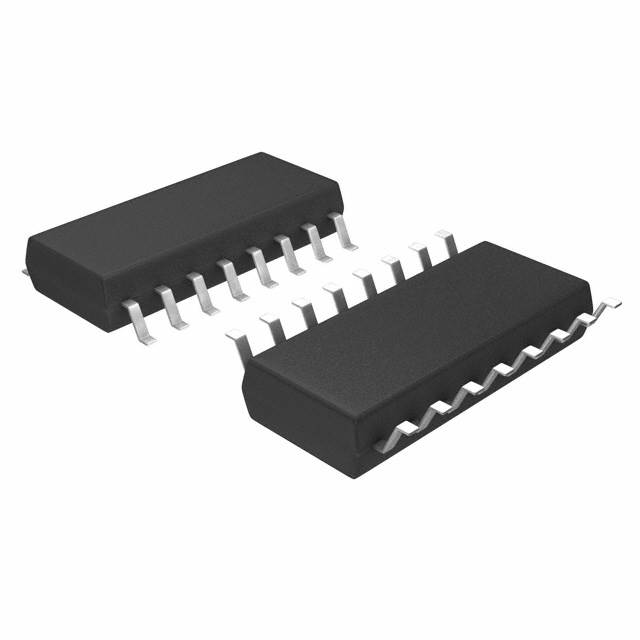Lihat spesifikasi untuk detail produk.

SN74LVC157ANSR
Product Overview
- Category: Integrated Circuit (IC)
- Use: Data Selector/Multiplexer
- Characteristics:
- Low-voltage CMOS technology
- High-speed operation
- Wide operating voltage range
- Low power consumption
- Package: SOIC-16
- Essence: The SN74LVC157ANSR is a quad 2-input multiplexer that allows data from four different sources to be selected and routed to a single output line.
- Packaging/Quantity: Tape and Reel, 2500 units per reel
Specifications
- Supply Voltage Range: 1.65V to 5.5V
- Input Voltage Range: 0V to VCC
- Output Voltage Range: 0V to VCC
- Operating Temperature Range: -40°C to +85°C
- Propagation Delay Time: 3.8ns (typical)
- Maximum Quiescent Current: 10μA
- Maximum Output Current: ±24mA
Detailed Pin Configuration
The SN74LVC157ANSR has a total of 16 pins arranged as follows:
__ __
A1 |1 \__/ 16| VCC
B1 |2 15| Y
A2 |3 14| B
B2 |4 13| C
G1 |5 SN 12| D
G2 |6 74 11| GND
Y1 |7 LVC 10| G3
Y2 |8 157 9| G4
----------
Functional Features
- Quad 2-input multiplexer with common select inputs (S0, S1)
- Allows selection of one of four data inputs (A, B, C, D) to be routed to the output (Y)
- High-speed operation allows for efficient data selection in various applications
- Low power consumption makes it suitable for battery-powered devices
- Wide operating voltage range enables compatibility with different systems
Advantages and Disadvantages
Advantages: - Compact size and high integration - Low power consumption - Wide operating voltage range - Fast switching speed
Disadvantages: - Limited number of input channels - Not suitable for applications requiring more complex data routing
Working Principles
The SN74LVC157ANSR operates based on the principle of multiplexing. It uses two select inputs (S0, S1) to determine which of the four data inputs (A, B, C, D) is connected to the output (Y). The selected input is then transmitted to the output line while the non-selected inputs are disconnected.
Detailed Application Field Plans
The SN74LVC157ANSR can be used in various applications, including but not limited to: - Data routing and selection in microcontrollers and digital systems - Address decoding in memory systems - Signal routing in communication systems - Input selection in audio/video equipment - Multiplexing in test and measurement instruments
Detailed and Complete Alternative Models
- CD74HC157E: Quad 2-input multiplexer with similar characteristics and pin configuration
- MC74VHC157DTR2G: High-speed CMOS quad 2-input multiplexer with extended temperature range
- 74ACT157SCX: Advanced CMOS quad 2-input multiplexer with Schmitt-trigger inputs
These alternative models offer similar functionality and can be considered as substitutes for the SN74LVC157ANSR depending on specific requirements.
Word count: 346 words
Sebutkan 10 pertanyaan dan jawaban umum terkait penerapan SN74LVC157ANSR dalam solusi teknis
Sure! Here are 10 common questions and answers related to the application of SN74LVC157ANSR:
Q: What is SN74LVC157ANSR? A: SN74LVC157ANSR is a quad 2-input multiplexer IC (Integrated Circuit) that can be used in various technical solutions.
Q: What is the purpose of SN74LVC157ANSR? A: The purpose of SN74LVC157ANSR is to select one of four data inputs and route it to a single output based on the control inputs.
Q: What is the voltage range supported by SN74LVC157ANSR? A: SN74LVC157ANSR supports a voltage range from 1.65V to 5.5V, making it compatible with a wide range of systems.
Q: How many control inputs does SN74LVC157ANSR have? A: SN74LVC157ANSR has two control inputs, which determine the selection of the data inputs.
Q: Can SN74LVC157ANSR handle high-speed signals? A: Yes, SN74LVC157ANSR is designed to handle high-speed signals and has a propagation delay of only a few nanoseconds.
Q: What is the maximum operating frequency of SN74LVC157ANSR? A: SN74LVC157ANSR can operate at frequencies up to 100 MHz, making it suitable for many applications.
Q: Does SN74LVC157ANSR have any built-in protection features? A: Yes, SN74LVC157ANSR has built-in ESD (Electrostatic Discharge) protection, which helps safeguard against damage during handling or operation.
Q: Can SN74LVC157ANSR be used in battery-powered devices? A: Yes, SN74LVC157ANSR has a low power consumption and can be used in battery-powered devices without significantly draining the battery.
Q: What is the package type of SN74LVC157ANSR? A: SN74LVC157ANSR comes in a small-outline integrated circuit (SOIC) package, which is commonly used in electronic applications.
Q: Are there any application notes or reference designs available for SN74LVC157ANSR? A: Yes, Texas Instruments provides application notes and reference designs that can help users understand and implement SN74LVC157ANSR in their technical solutions.
Please note that the answers provided here are general and may vary depending on specific requirements and use cases. It's always recommended to refer to the datasheet and documentation provided by the manufacturer for accurate information.

